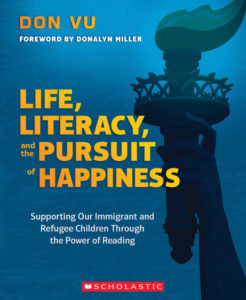Empower Refugee Kids with Reading Support
Life, Literacy, and the Pursuit of Happiness: Supporting Our Immigrant and Refugee Children Through the Power of Reading
By Don Vu
(Scholastic, 2021 – Learn more)
Reviewed by Beth Hassinger


At Barrett Ranch, Don Vu was the principal looking to change the reading culture. He noticed that most students had the “fundamentals” mastered, but their progress was stagnating because they weren’t reading any more than they had to. His school’s situation sounds very similar to the school where I am currently working and eerily similar to those that where I have worked previously.
For years I have worked to more meaningful literacy opportunities to students and their teachers in my role as a reading specialist. As a once former non-reader turned avid reader, I am continually looking for ways to show other non-readers what books have to offer.
My professional interest also has me considering ways to ensure that I provide multiple perspectives in my classroom. This book’s title suggested that two areas of interest for me would come together in a powerful way.
With so much focus on literacy standards that are tied to standardized testing, I believe we have short-changed students, who deserve a reading experience that includes more time, flexibility and choice. We need reading programs that emphasize engagement and help students grow strategies and skills they need to make voluntary reading a lifelong endeavor.
Don Vu is raising this issue in his book and challenging educators and school systems to consider that if education is the way to freedom and the “pursuit of happiness,” we need to recommit ourselves to the idea that reading is the heart of learning.
What’s in the book
The book is broken into three parts: Life, Literacy, and the Pursuit of Happiness. Within those three parts, Vu goes into great depth about six conditions to create a culture of literacy for all: commitment, clock, conversation, collection, connection, and celebration.
Part 1: Life
In this section of the book, Vu discusses the need for:
► Books in which students see themselves reflected both in the characters and the experiences.
► All students, regardless of ability, having time in their day for independent reading.
► Creating a culture of reading, with books everywhere, from Little Free Libraries to books in the office.
► Getting teachers, and students and parents to partner in this work.
I appreciate when authors mention other authors who have influenced their thinking. For Don Vu this includes Donalyn Miller, Steven Layne, Dr. Rudine Sims Bishop, Richard Allington, and others. These are names that I have seen repeatedly and whose work I also turn to, so I find his endorsements reassuring – and it brings credibility to the work educators at Barrett Ranch are doing.
What was new to me, and the essence of this book, was taking this work further and considering how creating a culture of reading can have an impact on the lives of immigrants and refugees. Vu starts each chapter with a memory of his own experience as an immigrant to this country and a refugee. This makes the work personal to him as it is rooted in his lived experience.
While his personal experiences could only be a window for me, the book underscores how important it is for me to create a reading culture. I have seen in my own life – going from non-reader to avid reader – how much influence engaged reading has on individual lives.
Part 2: Literacy
This part of the book goes into the first four conditions for creating a culture of literacy for all. In the chapter on commitment, Vu discusses not only committing to a vision for literacy, but also committing to valuing our students’ backgrounds and cultures.
Particularly eye opening for me was the reference to a study done at the University of Oregon and the Leibniz Institute for Research and Information Education. In this study they looked at the impacts of using the term “English learner.” They found that this classification can have a “direct and negative effect on teachers’ perceptions of students’ academic skills.” (Some language specialists are suggesting the term “Multilingual learner.”)
When it comes to time, we often feel that we are up against the clock. In this chapter, Vu discusses how important it is to prioritize making time for reading within the school day, but also how we partner with parents to make sure that reading is carried over into students’ home lives. You’ll also find in this chapter clear guidance on what independent reading is and isn’t and how libraries can support these efforts.
The chapter on conversation was one of my favorites. Learning is a social construct. Vu offers lots of ways to get students talking about books. Many of these suggestions, such as book clubs, book talks, and watching book trailers, are ways that I engage with books every day. It is in my opinion that schools should be focusing their efforts here when it comes to reading rather than performance on standardized tests. I believe that if educators focus their efforts on the conversational aspects of reading, we will see the outcomes reflected in standardized tests.
An essential consideration for creating a culture of reading for all would be the collections of books that are made available to students. Again, the information in this chapter wasn’t new for me, but schools that need to further diversify their book collections will find lots of ideas for teachers or schools to curate a selection in which all students can see themselves and see value in their full humanity.
Part 3: Pursuit of Happiness
In this last section of the book Vu discusses connection, celebration, and compassion. Keys to connection are that children are exposed to multiple perspectives with opportunities to examine their own biases, that they build background knowledge through books to make connections to the world at large, and that as educators we are making connections with students that help us learn more about their experiences and interests.
At Barrett Ranch, Vu talks about the various ways they celebrated reading, offering ideas for connecting with authors and how families can support the school’s efforts throughout the school year and in the summer.
He goes into detail about how Barrett Ranch partnered with IKEA to create reading lounges. Each reading lounge had its own theme, and Vu offers ideas for how you can replicate these reading lounges without an IKEA grant. This is a project that I want to undertake at some point in my career!
While compassion wasn’t considered as one of the six conditions, in this last chapter Vu connects compassion to each of the conditions.
My favorite things about the book
Overall, some of the information throughout the book was not new to me, but the stance of thinking about these conditions from the standpoint of how they can help our immigrant and refugee students was refreshing. I would recommend this book for any K-12 school looking to prioritize a reading culture.
There are ideas here that are not specific to an age group. Rather they are specific to creating readers who will read as a matter of choice instead of reading as a condition of compliance.
Other features of this book that I greatly appreciated:
► It was under 150 pages. I’m so happy to see publishers who honor teacher time when they make decisions about length. When you are managing so many things that sometimes feel insurmountable, you appreciate a book with a length that you know you can finish.
► As a reader, I am also partial to authors who point to other titles where I can learn more about ideas they may have briefly touched upon.
► Vu did my favorite thing when I’m reading most books: he included wonderful quotes at the beginning of each chapter. Words are important, so to capture the important words of others makes this reader’s heart happy.
If you are going to focus on changing the culture of your building to make reading engagement a top priority, Life, Literacy, and the Pursuit of Happiness: Supporting Our Immigrant and Refugee Children Through the Power of Reading needs to be included among your resources as you move forward.
Beth Hassinger works as a reading specialist at a K-5 building in a suburb north of Chicago, IL. She is currently working on a second Master’s in Educational Leadership. Having not read much as a child, she is continually looking for ways to engage readers and invite them to see the wonder that lifelong reading is. You can find her on Twitter @SL_Reader.




































